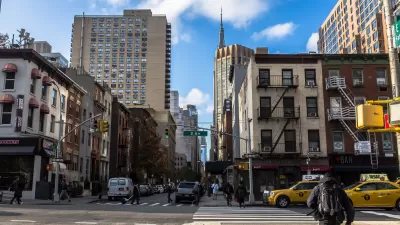Buoyed by a recovering real estate market, and a race to build the tallest and most exclusive residential towers in the city, Manhattan is experiencing a surge in air-rights deals. Robin Finn explores the nuances of this complex market.
Established by New York City with 1916 and 1961 zoning regulations, the sale of air rights, or transfer of development rights (T.D.R.'s), "have become the reigning currency of the redevelopment realm, major components in the radical vertical transformation of [New York City's] skyline," writes Finn. "With Manhattan’s skyscraper-proof bedrock in finite supply and the city’s fixation on housing and envelope-pushing office buildings on the upswing — and also the impetus behind the proposed rezoning of 70 blocks around Grand Central Terminal called Midtown East — the sky is not only the limit, it’s the solution."
"These days developers don’t just tailor their blueprints to the lot they own: they often annex, for fees that can run into the multimillions, the airspace above and around their property," he explains. "The process, essentially an invisible merger of building lots that tranlates [sic] into taller, heftier towers with increased profitability, is emerging from a minislump dictated by the economy."
“The trading of air rights is more prevalent than it’s ever been before,” said Robert Von Ancken, an air-rights expert and appraiser who is the chairman of Landauer Valuation and Advisory Services, “and it’s why you’re seeing these monster buildings springing up all over town. All of these new supertowers that are changing the look of the city’s horizon, they couldn’t happen without air-rights transfers.”
But the explosive trend in building as high as possible isn't without its hazards. “Is the future of the city going to be this series of 200-story towers with stultified buildings in between?” asks Robert A. Jacobs, a land-use specialist and partner at Belkin Burden Wenig & Goldman. “You wonder how this will affect the street life, the trees. You wonder about urban plazas surrounded by 50-story walls: what would grow there, mushrooms?”
FULL STORY: The Great Air Race

Alabama: Trump Terminates Settlements for Black Communities Harmed By Raw Sewage
Trump deemed the landmark civil rights agreement “illegal DEI and environmental justice policy.”

Study: Maui’s Plan to Convert Vacation Rentals to Long-Term Housing Could Cause Nearly $1 Billion Economic Loss
The plan would reduce visitor accommodation by 25% resulting in 1,900 jobs lost.

Planetizen Federal Action Tracker
A weekly monitor of how Trump’s orders and actions are impacting planners and planning in America.

DC Extends Application Window for Outdoor Dining Permits
District restaurants will have until the end of November to apply, but businesses with permits in rush hour parking lanes must end operations on July 31.

Wind Energy on the Rise Despite Federal Policy Reversal
The Trump administration is revoking federal support for renewable energy, but demand for new projects continues unabated.

Passengers Flock to Caltrain After Electrification
The new electric trains are running faster and more reliably, leading to strong ridership growth on the Bay Area rail system.
Urban Design for Planners 1: Software Tools
This six-course series explores essential urban design concepts using open source software and equips planners with the tools they need to participate fully in the urban design process.
Planning for Universal Design
Learn the tools for implementing Universal Design in planning regulations.
Caltrans
Smith Gee Studio
Institute for Housing and Urban Development Studies (IHS)
City of Grandview
Harvard GSD Executive Education
Toledo-Lucas County Plan Commissions
Salt Lake City
NYU Wagner Graduate School of Public Service



























